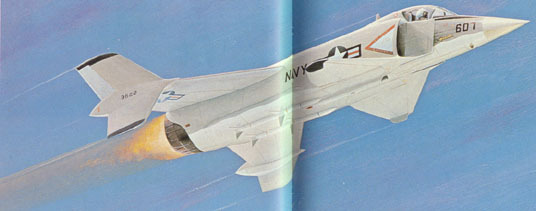#Rockwell XFV-12A
Text

Rockwell XFV-12A

Rockwell XFV-12A
by Alex Stoll

Around 1970 the Navy could not see how it was going to be able to replace its old Essex and Midway carriers with Nimitz-class supercarriers. Admiral Elmo Zumwalt directed a study of alternatives which resulted in the Sea Control Ship (SCS), a mini-carrier equipped with V/STOL fighters and ASW aircraft. The USN invited manufactures to propose demonstration programs for a new aircraft, called the V/STOL Fighter Technology Prototype, to replace the outdated Harrier and serve on the SCS or other ships much smaller than conventional carriers: BAe and MD proposed an improved Harrier and a supersonic Harrier with a PCB (Plenum-Chamber Burning) engine; Boeing and Northrop proposed jet-powered tail-sitters; Lockheed-California proposed a propeller-driven tail-sitter; and Rockwell proposed a canard-delta aircraft powered by a large and enormously powerful engine that used the ejector-lift system for V/STOL. The Navy awarded the contract to Rockwell in 1972, instead of choosing designs based on proved technology, and the XFV-12A designation (twelth in the V series, not in the F series; the F-12 was the interceptor verison of the Blackbird) was allotted. Even though the forward fuselage and landing gear of the A-4 and the wing box, air intakes, and fuel tanks of the F-4 were used to speed the program up, it still ran far behind schedule. The prototype was rolled out in December 1976 and the first flight was scheduled for 1979.

Engine Configuration
For takeoff and landing, the entire engine was ducted to hollow-section "ejector flaps" (also called augmentor flaps) out along the wings and the canard by pilot command via a diverter valve box. The high-energy hot gas forced fresh air from above through the ejector flaps at a ratio of 7.5:1 to boost thrust by 70 percent. The ejector flaps could be raised or lowered to provide a smooth transition from vertical to horizontal flight or vice versa. After the XFV-12A's cancellation, de Havilland Canada designed an aircraft with ejectors build into the roots of a delta wing. GD incorporated their concept into the E-7, a F-16-based delta-winged STOVL aircraft. DHC built a large powered model and tested it in 1987. The EL system was large and control was difficult as a result of the large air mass moving through the wing root during transition, and nothing came of it (though not because the EL couldn't produce enough thrust as in the XFV-12A's case) despite the attractive low exhaust velocity.

Cancellation
Rockwell and Pratt & Whitney experienced several major technical problems, and the thrust boost from the ejector flap system was never as large in the full-scale aircraft as predicted from data collected by test rigs and sub-scale models; the XFV-12A could not leave the ground. Eventually funding dried up, the SCS was canceled, and the program proved a disappointment; however, in most future ASTOVL programs, large-scale powered models were used because of the experience gained in the XFV-12A program.

123 notes
·
View notes
Text

Robert Sullivan Following
North American XFV-12A (Rockwell XFV-12) on the ramp at N.A.A., Columbus, Ohio on August 26, 1977.
10 notes
·
View notes
Text

Robert Sullivan Following
North American XFV-12A (Rockwell XFV-12) on the ramp at N.A.A., Columbus, Ohio on August 26, 1977.
4 notes
·
View notes
